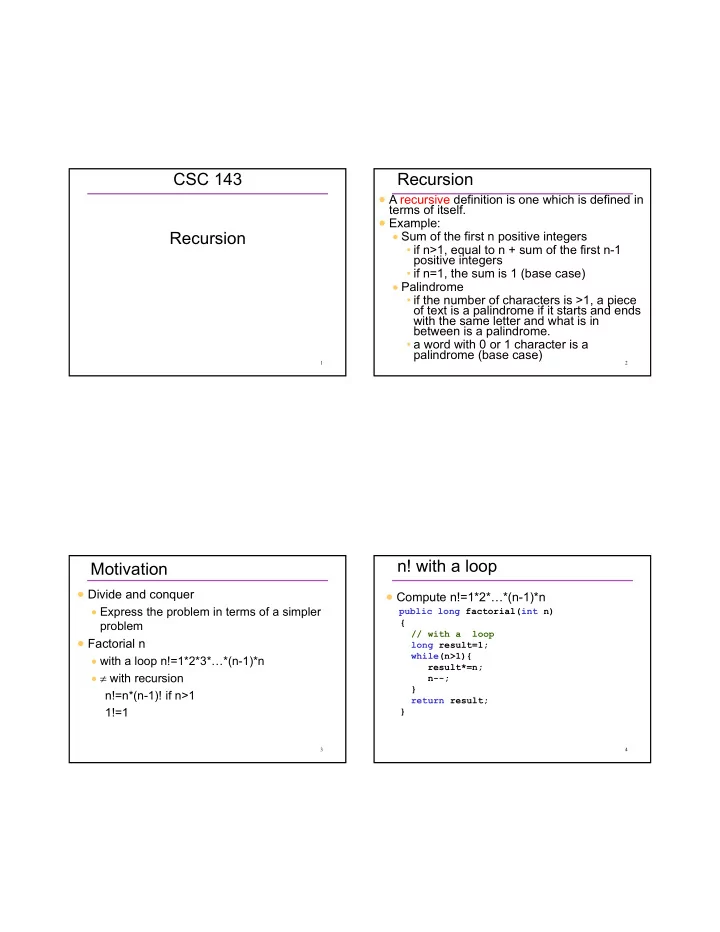

CSC 143 Recursion A recursive definition is one which is defined in terms of itself. Example: Sum of the first n positive integers Recursion • if n>1, equal to n + sum of the first n-1 positive integers • if n=1, the sum is 1 (base case) Palindrome • if the number of characters is >1, a piece of text is a palindrome if it starts and ends with the same letter and what is in between is a palindrome. • a word with 0 or 1 character is a palindrome (base case) 1 2 n! with a loop Motivation Divide and conquer Compute n!=1*2*…*(n-1)*n Express the problem in terms of a simpler public long factorial(int n) { problem // with a loop Factorial n long result=1; while(n>1){ with a loop n!=1*2*3*…*(n-1)*n result*=n; with recursion n--; } n!=n*(n-1)! if n>1 return result; 1!=1 } 3 4
n! with recursion factorial(4) different memory 24 (=4!) locations Write n!=n*(n-1)! 4 n public long factorial(int n) 4 * factorial(3) result { 6 // with recursion 3 n long result; if (n>1) 3 * factorial(2) result result=n*factorial(n-1); else 2 2 n result=1; // base case return result; 2 * factorial(1) result } How does it work? Recall that a method 1 n call is done by value in java. 1 1 result 5 6 Activation Records Infinite Recursion Make sure that recursion will eventually end Recall that local variables and parameters are with one of the base cases. allocated when a method is entered, deleted public long factorial(int n) { when the method exits (automatic storage). long result = factorial(n-1); //oups! Whenever a method is called, a new if ( n==1) // the control flow never gets activation record is pushed on the call stack, // to this line containing: result=1; else a separate copy of all local variables result *=n; control flow info (e.g. return address) return result; } Activation record is popped at end of method What happens? Whatever the value of n, A recursive method call is handled the same factorial(n-1) is called. It ends with a stack overflow error. way Make sure that you test for the base case Each recursive call has its own copy of before calling the method again. locals 7 8
Recursion versus loops The towers of Hanoi (1) Any recursive algorithm can be rewritten as an iterative algorithm What is best? Some problems are more elegantly solved Move the tower of disks from the left to the with recursion. Others with iterations. right peg. Recursion is slightly more expensive. An A larger disk can't be placed on top of a activation record is pushed on and later popped from the stack for each recursive call smaller disk. Solution? Beautifully solved with recursion. More difficult with a loop. 9 10 The towers of Hanoi (2) The towers of Hanoi (3) public void move Recursive algorithm: move n disks in terms of (int n,int peginit,int pegfinal, int pegtemp) { moving n-1 disks // move n disks from peginit to pegfinal, using // pegtemp as a temporary holding area Base case: 1 disk if (n ==1) To move n disks from the left to the right peg, {System.out.println("move top disk from "+ peginit+" to " + pegfinal);} • move the n-1 top disks from the left to the else middle peg { //move n -1 disks to pegtemp • move the one remaining disk on the left move(n-1,peginit,pegtemp,pegfinal); peg to the right peg //move the remaining disk to pegfinal move(1,peginit,pegfinal,pegtemp); • move the n-1 disks on the middle peg to //move n -1 disks to pegfinal the right peg. move(n-1,pegtemp,pegfinal,peginit); } } 11 12
Recommend
More recommend